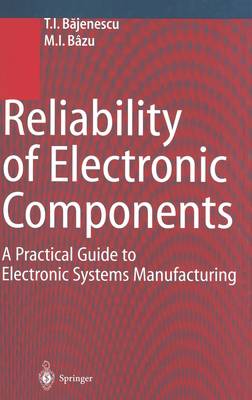
- Afhalen na 1 uur in een winkel met voorraad
- Gratis thuislevering in België vanaf € 30
- Ruim aanbod met 7 miljoen producten
- Afhalen na 1 uur in een winkel met voorraad
- Gratis thuislevering in België vanaf € 30
- Ruim aanbod met 7 miljoen producten
Zoeken
Reliability of Electronic Components
A Practical Guide to Electronic Systems Manufacturing
T I Bajunescu, T I Bajenescu, M I Bazu, Titu I Bajenescu, Marius I Bazu
Hardcover | Engels
€ 137,45
+ 274 punten
Omschrijving
1 Introduction.- 1.1 Definition of reliability.- 1.2 Historical development perspective.- 1.3 Quality and reliability.- 1.4 Economics and optimisation.- 1.5 Probability; basic laws.- 1.5.1 Probability distributions.- 1.5.2 Basic reliability distribution theory.- 1.6 Specific terms.- 1.6.1 The generalised definition of l and MTBF.- 1.7 Failures types.- 1.7.1 Failures classification.- 1.8 Reliability estimates.- 1.9 "Bath-tub" failure curve.- 1.10 Reliability of electronic systems.- 1.10.1 Can the batch reliability be increased?.- 1.10.2 What is the utility of screening tests?.- 1.10.3 Derating technique.- 1.10.4 About the testability of electronic and telecommunication systems.- 1.10.5 Accelerated ageing methods for equipped boards.- 1.10.6 Operational failures.- 1.10.7 FMEA/FMECA method.- 1.10.8 Fault tree analysis (FTA).- 1.10.8.1 Monte Carlo techniques.- 1.10.9 Practical recommendations.- 1.10.10 Component reliability and market economy.- 1.11 Some examples.- References.- 2 State of the Art in Reliability.- 2.1 Cultural features.- 2.1.1 Quality and reliability assurance.- 2.1.2 Total quality management (TQM).- 2.1.3 Building-in reliability (BIR).- 2.1.4 Concurrent engineering (CE).- 2.1.5 Acquisition reform.- 2.2 Reliability building.- 2.2.1 Design for reliability.- 2.2.2 Process reliability.- 2.2.2.1 Technological synergies.- 2.2.3 Screening and burn-in.- 2.2.3.1 Burn-in.- 2.2.3.2 Economic aspects of burn-in.- 2.2.3.3 Other screening tests.- 2.2.3.4 Monitoring the screening.- 2.3 Reliability evaluation.- 2.3.1 Environmental reliability testing.- 2.3.1.1 Synergy of environmental factors.- 2.3.1.2 Temperature cycling.- 2.3.1.3 Behavior in a radiation field.- 2.3.2 Life testing with noncontinous inspection.- 2.3.3 Accelerated testing.- 2.3.3.1 Activation energy depends on the stress level.- 2.3.4 Physics of failure.- 2.3.4.1 Drift, drift failures and drift behaviour.- 2.3.5 Prediction methods.- 2.3.5.1 Prediction methods based on failure physics.- 2.3.5.2 Laboratory versus operational reliability.- 2.4 Standardisation.- 2.4.1 Quality systems.- 2.4.2 Dependability.- References.- 3 Reliability of Passive Electronic Parts.- 3.1 How parts fail.- 3.2 Resistors.- 3.2.1 Some important parameters.- 3.2.2 Characteristics.- 3.2.3 Reasons for inconstant resistors [3.8]...[3.10].- 3.2.3.1 Carbon film resistors (Fig. 3.4).- 3.2.3.2 Metal film resistors.- 3.2.3.3 Composite resistors (on inorganic basis).- 3.2.4 Some design rules.- 3.2.5 Some typical defects of resistors.- 3.2.5.1 Carbon film resistors.- 3.2.5.2 Metal film resistors.- 3.2.5.3 Film resistors.- 3.2.5.4 Fixed wirewound resistors.- 3.2.5.5 Variable wirewound resistors.- 3.2.5.6 Noise behaviour.- 3.3 Reliability of capacitors.- 3.3.1 Introduction.- 3.3.2 Aluminium electrolytic capacitors.- 3.3.2.1 Characteristics.- 3.3.2.2 Results of reliability research studies.- 3.3.2.3 Reliability data.- 3.3.2.4 Main failures types.- 3.3.2.5 Causes of failures.- 3.3.3 Tantalum capacitors.- 3.3.3.1 Introduction.- 3.3.3.2 Structure and properties.- 3.3.3.3 Reliability considerations.- 3.3.3.4 DC/C0 variation with temperature.- 3.3.3.5 The failure rate and the product CU.- 3.3.3.6 Loss factor.- 3.3.3.7 Impedance at 100 Hz.- 3.3.3.8 Investigating the stability of 35 V tantalum capacitor.- 3.3.3.9 The failure rate model.- 3.3.4 Reliability comparison.- 3.3.5 Another reliability comparison.- 3.3.6 Polyester film / foil capacitors.- 3.3.6.1 Introduction.- 3.3.6.2 Life testing.- 3.3.6.3 1 as a function of temperature and load.- 3.3.6.4 Reliability conclusions.- 3.3.7 Wound capacitors.- 3.3.8 Reliability and screening methods [3.37] [3.38].- 3.4 Zinc oxide (ZnO) varistors [3.39]...[3.45].- 3.4.1 Pulse behaviour of ZnO varistors.- 3.4.2 Reliability results.- 3.5 Connectors.- 3.5.1 Specifications profile.- 3.5.2 Elements of a test plan.- References.- 4 Reliability of Diodes.- 4.1 Introduction.- 4.2 Semiconductor diodes.- 4.2.1 Structure and properties.- 4.2.2 Reliability tests and results.- 4.2.3 Fail...
Specificaties
Betrokkenen
- Auteur(s):
- Uitgeverij:
Inhoud
- Aantal bladzijden:
- 558
- Taal:
- Engels
Eigenschappen
- Productcode (EAN):
- 9783540657224
- Verschijningsdatum:
- 28/05/1999
- Uitvoering:
- Hardcover
- Formaat:
- Genaaid
- Afmetingen:
- 156 mm x 234 mm
- Gewicht:
- 952 g

Alleen bij Standaard Boekhandel
+ 274 punten op je klantenkaart van Standaard Boekhandel
Beoordelingen
We publiceren alleen reviews die voldoen aan de voorwaarden voor reviews. Bekijk onze voorwaarden voor reviews.








